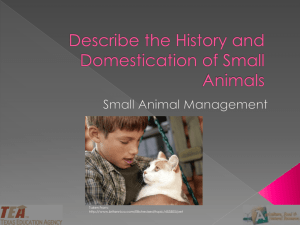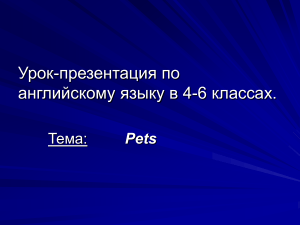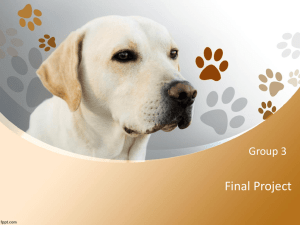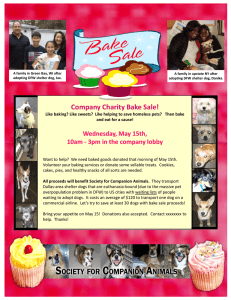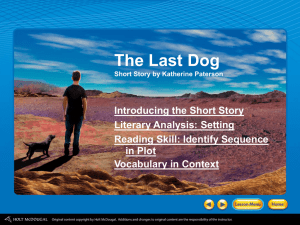Teleclass SLIDES
advertisement
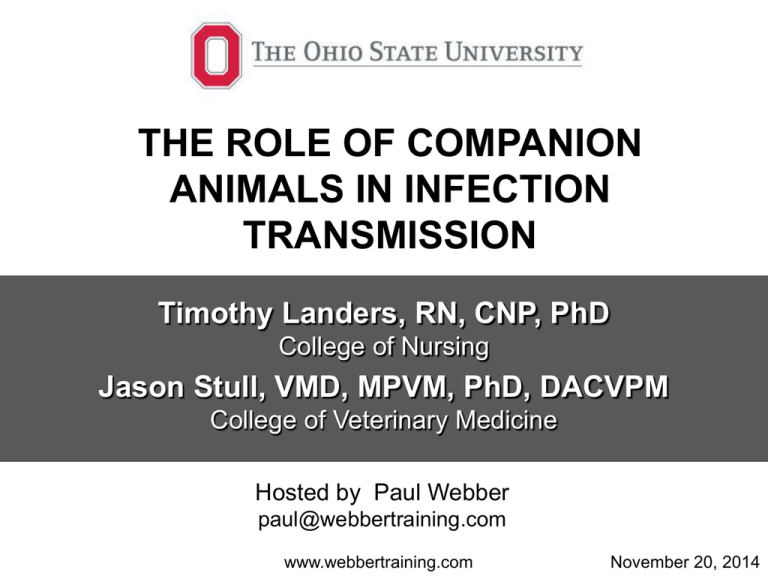
THE ROLE OF COMPANION ANIMALS IN INFECTION TRANSMISSION Timothy Landers, RN, CNP, PhD College of Nursing Jason Stull, VMD, MPVM, PhD, DACVPM College of Veterinary Medicine Hosted by Paul Webber paul@webbertraining.com www.webbertraining.com November 20, 2014 Conflict of Interest Statement The presenters declare they have no competing interests 2 Learning Objectives • Describe features of the human-animal bond and its implications for human health and infection prevention • Define zoonotic transmission and describe the role of pets in zoonotic outbreaks • Identify key strategies for preventing pet-associated zoonotic transmission in healthcare settings 3 HUMAN-ANIMAL BOND AND ITS IMPLICATIONS FOR HUMAN HEALTH AND INFECTION PREVENTION 4 5 Dogs are special • • • • • • • Co-evolution of dogs and humans Historical importance Family members Usefulness to humans Emotional and psychological important Social and cultural taboos Human health benefits 6 Human-Animal Bond • Often strong bonds between pets and owners – Adults with HIV: source of support, protect against loneliness1 – Adult cancer patients: high attachment, provide health benefits2 – Immunocompromised children3 1 Siegel 1999 2 Larson 2010 3Stull 2014 8 Human-Animal Bond • Relationship between people and their pets • HAI = human-animal interaction – Encompass human-animal bond from pet ownership, recreation (horseback riding), animal husbandry, therapy 9 Human-pet dog interactions • Types of interactions – Determinants of interactions – Characteristics of interactions • Frequency • Social lives of dogs and dog owners • Interest in human benefits of interacting with animals 11 Human-Animal Bond • Distress & social isolation: ↓ health • Often strong bonds pets and owners • ↓ stress, anxiety, loneliness, depression1 • ↓ risk cardiovascular disease2 • Children: better social skills, self-esteem, empathy3 1 Friedmann 2009 2 Patronek 1993 3 Melson 1997 Human-Pet Scales • • • • • Lexington Attachment to Pets Scale (LAPS) Pet Attitude Scale (PAS) People and their pets instrument Pet Relationship Scale Monash Dog Ownership Relationship Scale (MDORS) 13 OPRS: citation available 14 Physiologic Benefits • • • • • Ownership, AAA & AAT “Low” and “high” stress situations Variety of species ↓ health-care expenditures Owned and loaner pets – Dog-walking program (72% adherence) • Some document benefits for animals involved – ↓ blood pressure Johnson, 2010 Psychosocial Benefits • “High-risk” groups – Nursing home • ↑ prosocial behavior in residents • ↑ positive interactions in staff – AIDS – Children autism • Interactions/perceived likability Johnson, 2010 16 17 18 http://thehydrant.files.wordpress.com/2012/06 19 Children With Pets • Improved – Social skills – Self-esteem – Empathy • As likely to talk to their pets about their emotions and secret experiences as with their siblings 20 Immunocompromised • Mental & physical isolation • HIV-infected: – – – – Pet as family member Source of support and affection Protect against loneliness Pet-owners with AIDS less depression than non-pet owners • Cancer patients: – High level of attachment to pets – Having a pet provided health benefits (67%) • Lung transplant recipients – Pets ownership associated better quality of life 21 Health Benefits • Distress and social isolation negative health effects • Depression and anxiety – ↑ catecholamine release – ↑ corticosteroids – ↓myocardial perfusion (heart blood flow) • Improve health – Improve psychosocial status – Reduce distress and stress responses – Moderate social interaction 22 Human-pet dog interactions • Types of interactions – Determinants of interactions – Characteristics of interactions • Frequency • Social lives of dogs and dog owners • Interest in human benefits of interacting with animals 23 ROLE OF PETS IN ZOONOTIC TRANSMISSION & OUTBREAKS 26 Zoonoses • Naturally transmitted from animals to people • Of 1,415 species pathogenic to people – 61% zoonotic – 75% emerging pathogens zoonotic 1 Taylor 2001 27 Share and Share Alike1 • Many factors shape human microbial community – Household members – Children – Dogs • Household members more alike, esp. if dogs • Dog-owners shared more skin microbiota with own dog 1 Song 2013 28 Elements for Effective Pet-Human Transmission • Pathogens with a broad host range • Opportunities for exposure 29 Pet-Related Risk Factors for Zoonotic Disease • Species • Diet • Age • Immunity • Prior antibiotic use • Opportunities for transmission • Opportunities for exposure • Source, travel • Management • Hospitalization • Contact with high-risk people 30 Pet-Associated Disease • 70+ pathogens of “pets” transmissible to people • Pets often subclinical shedding • Emerging & remerging diseases • Animal and human reservoirs – Dogs visiting human healthcare facilities1 • C. difficile (OR=2.4) • MRSA (OR=4.7) 1 Lefebvre 2009 31 Pet-Associated Disease Risks • Disease risk greatest – Extremes of age (<5 yrs, ≥ 65 yrs) – Pregnant – Immunocompromised • Higher risk groups – Particular pathogens – Longer duration – More severe/unexpected complications 32 Pet-associated Infections of Greatest Concern • • • • • • • • • • • Bartonella spp. Campylobacter spp. Capnocytophaga canimorsus Cryptosporidium spp. Dermatophytes Giardia lamblia Lymphocytic choriomeningitis virus MDROs (e.g., ESBLs, MRSA) Pasteurella spp. Salmonella spp. Toxoplasma gondii 33 Staphylococcus aureus • Common human pathogen • Uncommon canine pathogen • Colonizes approx. 30% of US residents • Approx. 10% of dogs colonized • Can contain resistance & virulence factors Staphylococcus pseudintermedius • Common canine pathogen • Uncommon human pathogen • Can contain resistance & virulence factors • Colonization in dogs and humans not well studied 34 Disease Attributable to Pets • Poorly understood – – – – Most not reportable Numerous exposure sources Subclinical carriage/shedding Reactivation during immunosuppression • Thought to be low1,2 • Risk not uniform – Species, age, immune status – High morbidity, mortality for some individuals 1 Angulo 1995 2 Glaser 1994 35 36 Setting Author, year Faires, et.al., 2009 (16) US and Canada Weese, 2006 (11) U.S. and Canada Baptiste, et. al., 2005 (17) Small animal hospital, UK Van Duijkeren, et.al., 2004 (18) Nursing home outbreak, Netherlands Enoch, 2004 (19) Pet therapy dog, UK Manian, 2003 (10) Case report, US Table 1. Studies on the role of pets in SA/MRSA colonization and infection. Findings 22 households in which pet had MRSA infection 10/56 (27.3%) of humans and 2/24 (8.3%) of non-infected dogs were colonized 8 households with recurrent human MRSA infections 1/16 (6.3%) of humans and 2/21 dogs (9.5%) were colonized Humans and dogs shared same PFGE strain Contacts of 6 index dogs with MRSA infection were evaluated. 14/88 (16%) of human contacts were positive, one secondary infection was identified (in a non-index dog). 55 dogs from hospital were MRSA negative 3 dogs with clinical infections had identical strains to 3/11 (27%) colonized staff Investigation of 48 patients and 15 nurses who were MRSA colonized After unsuccessful decolonization of one nurse, daughter and dog identified as MRSA colonized Pet therapy dog reported as MRSA-negative before visiting hospital ward, but positive after visiting Patient and wife had recurrent MRSA infections with unsuccessful decolonization Therapy was successful only after treatment of dog Patient-dog isolates were similar based on PFGE 37 “Tie to Pets has germ jumping to and fro” New York Times A well known expert “estimated that relatively few animals were infected…’In the grand scheme of things with MRSA, pets are a pretty minor thing,’ he said.” “Can snuggling up to your pet give you MRSA?” Daily Mail, UK “However, all experts agree there is no need to give up your beloved pet.” A local veterinarian who treated a MRSA-infected cat saated, “the cat would have picked it up from a human carrier. It wasn’t the cat’s fault.” “Pets can give owners love, joy – and staph” The Columbus Dispatch According to one expert, “dogs and cats are getting it from people.” A national expert stated, “I don’t want people to thing they’re going to get MRSA from their pets. More commonly, people get it because they’re carrying it themselves.” “Beware of the dog: you may catch MRSA.” The Times Online “Risks of infection from dog to Man at present are low.” According to a local animal behavioralist, “you are more likely to catch a disease from a child than a dog. “MRSA in pets shouldn’t be a major concern.” KJCT News, Grand Junction, CO A local expert stated that MRSA in animals is “not that prevalent…so you know, I don’t think people need to become frightened that if they touch a dog or a dog touches them that they’re all of the sudden going to get this horrible bacterial disease.” 38 Pet-associated Infections of Greatest Concern • • • • • • • • • • • Bartonella spp. Campylobacter spp. Capnocytophaga canimorsus Cryptosporidium spp. Dermatophytes Giardia lamblia Lymphocytic choriomeningitis virus MDROs (e.g., ESBLs, MRSA) Pasteurella spp. Salmonella spp. Toxoplasma gondii 39 Campylobacter Outbreak1 1 Moffatt 2014 40 Higher Risk Animals: Young Dogs/Cats (< 6 months) • Higher prevalence of pathogens – Campylobacter spp. – Hook and roundworms (e.g., Toxocara) – Bartonella henselae • RF for human disease – Campylobacteriosis • <3yrs: puppy ownership (OR=17)1 • Adults: ↑ risk with puppy ownership2 • Any age dog with diarrhea3,4 1Tenkate, 2001 2Gras, 2013 3 Fullerton 2007 4Gillespie 2003 42 Higher Risk Animals: Reptiles & Amphibians • Ex: Turtle, lizard, snake, frog, salamander – High prevalence Salmonella – RF human salmonellosis • 6-11% all cases1 • Salmonella “travels”– hand hygiene, environmental disinfection – Feeder rodents contaminated/ colonized with Salmonella 1 Mermin 2004 43 Higher Risk Animals: Rodents • Ex: gerbil, hamster, guinea pig, mouse – Increased prevalence • Salmonella • Lymphocytic choriomeningitis virus (LCMV) 44 Higher Risk Animals: Exotics • Ex. Chinchilla, hedgehog – High prevalence • Salmonella • Other zoonotic pathogens? Higher Risk Animals: Young Farm Animals • Ex. Chicks, calves, piglets, lambs, goat kids – High prevalence • Salmonella • Cryptosporidium • Campylobacter • Clostridium difficile • E. coli O157 Risk Factors: Pet’s Diet • Dogs fed raw eggs or meat – 6x more likely to shed Salmonella1 • Outbreak: human salmonellosis associated with pig ear treats2 1 Leonard 2010 2 Clark 2001 47 Opportunities for Transmission • Pets often members of households • Frequent pet contact by non-pet owning1 • Ownership and species owned similar for higher-risk people • Non-home locations – Nursing homes, hospitals – AAT, AAI 1 Stull 2013 48 Opportunities for Transmission • Home high-risk practices frequent1 – Lick faces several times/wk (24%) – Fed high-risk foods (28%) • Dogs visiting health-care facilities1 – ≥ 1 zoonotic agent 80% of therapy dogs1 • Clostridium difficile • MDR Escherichia coli • Salmonella – Licked patients or accepted treats increased risk for MRSA and C. difficile 1 Stull 2014 2 Lefebvre 2009 49 Opportunities for Transmission • Of 90 therapy dog handlers1 – 20% used no infection control measures – 40% could not name a zoonotic disease – 79% allowed their dogs to lick patients 1 Lefebvre et al. 2006 50 KEY STRATEGIES FOR PREVENTING PET-ASSOCIATED ZOONOTIC TRANSMISSION 51 Overview of recommendations • Understand context! – Benefits vs. risks of animal contact • Hand hygiene • Variety of interactions – Human-animal-environment • Types and ages of animals • Pet health and husbandry practices 1 Lefebvre 2008 2Avery 2009 3Hemsworth 2006 52 Hand hygiene – Patients, visitors and HCWs before and after each animal contact – Portable ABHR – Follow facility’s protocols 53 Environmental controls • Disposable, impermeable barrier if animal placed on bed • Routine cleaning after visits 54 Personal Hygiene • Patients not eating/drinking during pet visit • Do not allow pets to lick patients/staff (esp. faces) • Allow feeding (treats) only if important • No pet contact with invasive devices, open or bandaged wounds, surgical incisions or other breaches in the skin, or medical equipment • Report and promptly wash bites and scratches Source: http://www.kidney.org.uk/ 55 Animal Contact and Husbandry Recommendations • Existing Guidelines – AAIs1 – Specific conditions2,3 • Benefits vs. risks of animal contact • Additional attention to – Personal hygiene – Types and ages of animals – Pet health and husbandry practices 1 Lefebvre 2008 2Avery 2009 3Hemsworth 2006 56 American Journal of Infection Control Volume 36, Issue 2, Pages 78–85, March 2008 57 General Concepts • Pathogen screening deemphasized – What pathogens? – How often (single point-in-time) – May be indicated in situations • Emphasis on infection control practices • Records for tracing if needed • Patient-owned vs. AAI/live-in – Patient: domestic companion animals; lenient if no other patient contact – AAI/live-in: restrictions important 58 Facility Program • Animal liaison (visits, housed) • Animal policies (e.g., AAI) – Part of formal program – Temperament testing – Evaluation by liaison; follow and revoke if problems – Training for handler (e.g., zoonoses, health, confidentiality) • Inclusion criteria 59 Animal Contact? • Immunocompromised patients assessed by health care provider to give OK and any limitations • Identify patients with – Animal phobias – Lack of interest – High risk • Appropriate locations – Escort by hospital personnel – Restrained by leash or cage 60 Restricted Areas • • • • • • Food preparation areas Operating rooms Neonatal nurseries Critical care Isolation High-risk areas with caution(e.g., dialysis, burn units) 61 Types and Ages of Animals • No high-risk animals – Species – Ages (cats/dogs > 1 yr) – Source: none recently from animal shelter, pound 62 Pet Health and Husbandry • No raw foods, chews, or treats of animal origin within the past 3 months • Annual health evaluation (veterinarian) • Vaccinations current (rabies) • Ectoparasite and endoparasite parasite control program Pet Health • No recent (i.e. in past wk) – – – – Vomiting/diarrhea Sneezing/coughing (susp infection) Urinary or fecal incontinence Antimicrobials (nontopical) or immunosuppressive doses of medications – Infections (e.g., open wounds, skin/ear) • Before visit – Brush/comb ± bathe – Nails short 64 Other Considerations • Patients (and medical personnel) often limited knowledge pet-associated disease1,2 – Risks – Reduction methods • Patient pet contact infrequently assessed1,2 • Veterinary counterparts useful resource, but limited interaction3 1 Stull 2013 2 Stull 2014 3 Hill 2012 65 Resources: Pet-Associated Disease 66 Resources: Pet-Associated Disease pawssf.org wormsandgermsblog.com 67 68 Hoet: citation available Zoonoses and the Public • Low level of knowledge • Low recall of receipt of information • Comfortable with current level of knowledge (6070%) • Frequent high-risk practices • Minimally concerned about zoonoses • Same for high-risk individuals 69 70 Reach out to Veterinary Colleagues • Survey of Connecticut health professionals – Comfortable advising clients about zoonoses • 45% of veterinarians • 6% of pediatricians – Ranking of responsibility for educating public re: zoonoses prevention 1 Gauthier 2002 71 Reach out to Veterinary Colleagues • Limited communication1 – 100% physicians never/rarely contacted veterinarians – 97% veterinarians never/rarely contacted physicians • Veterinarians unaware of clients’ immune status – 58% told about status (children with cancer)2 – 66% never discussed clients’ health3 1 Hill 2012 2 Stull unpublished 3 Grant 1999 72 Summary Pets provide important health benefits Disease risks is modifiable in most cases Identify higher risk pet husbandry practices Resources and guidance available 7373 December 2 (British Teleclass) UPDATE OF CLOSTRIDIUM DIFFICILE INFECTIONS IN EUROPE Prof. Ed Kuijper, Leiden University Medical Center, Germany December 4 CHEMOTHERAPY – HEALTH, SAFETY, AND WASTE MANAGEMENT ISSUES Ed Krisiunas, WNWN International, Connecticut December 11 ENVIRONMENTAL CLEANINGIN HEALTHCARE: IS MONITORING OF CLEANING COMPLIANCE REALLY NEEDED? Dr. Michelle Alfa, Diagnostic Services of Manitoba 74 75
